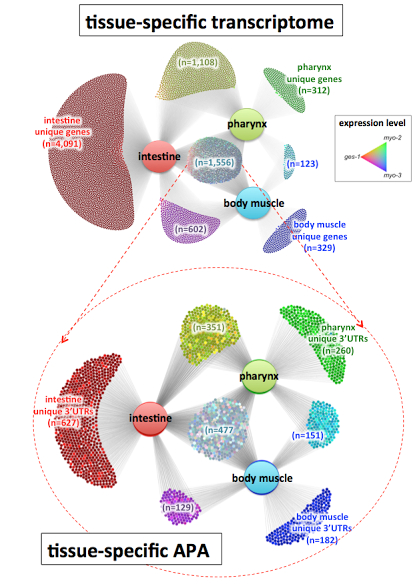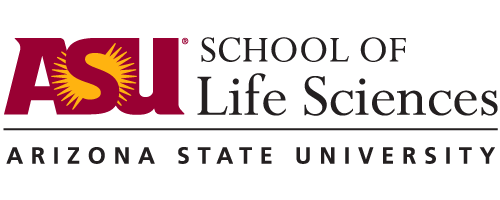About The UTRome
 Three-prime untranslated regions (3'UTRs) are widely recognized as important post-transcriptional regulatory regions of mRNAs. RNA-binding proteins and small non-coding RNAs such as microRNAs (miRNAs) bind to functional elements within 3'UTRs to influence mRNA stability, translation and localization. These interactions play many important roles in development, metabolism and disease.
Three-prime untranslated regions (3'UTRs) are widely recognized as important post-transcriptional regulatory regions of mRNAs. RNA-binding proteins and small non-coding RNAs such as microRNAs (miRNAs) bind to functional elements within 3'UTRs to influence mRNA stability, translation and localization. These interactions play many important roles in development, metabolism and disease.
However, even in the most well-annotated metazoan genomes, 3'UTRs and their functional elements are not well defined. Comprehensive and accurate genome-wide annotation of 3'UTRs and their functional elements is thus critical. We have developed this open-access database, to provide a rich and comprehensive resource for 3'UTR biology in the well-characterized, experimentally tractable model system Caenorhabditis elegans.
UTRome.org combines data from public repositories and large-scale efforts to characterize 3'UTRs and their functional elements in C. elegans, including 3'UTR sequences, graphical displays, predicted and validated functional elements, secondary structure predictions and detailed data from our cloning pipelines. UTRome.org will grow substantially over time to encompass individual 3'UTR isoforms for the majority of genes, new and revised functional elements, and in vivo data on 3'UTR function as they become available. The UTRome database thus represents a powerful tool to better understand the biology of 3'UTRs.
This work is supported by grants from the National Human Genome Research Institute (R21HG003971 and 1U01HG004276).
The UTRome website has been described in:
 The Landscape of C. elegans 3'UTRs.
The Landscape of C. elegans 3'UTRs.Mangone M, Manoharan AP, Thierry-Mieg D, Thierry-Mieg J, Han T, Mackowiak S, Mis E, Zegar C, Gutwein MR, Khivansara V, Attie O, Chen K, Salehi-Ashtiani K, Vidal M, Harkins TT, Bouffard P, Suzuki Y, Sugano S, Kohara Y, Rajewsky N, Piano F, Gunsalus KC, Kim JK.
Science DOI: 10.1126/science.1191244 (2010)
UTRome.org: a platform for 3'UTR biology in C. elegans.
Mangone M, Macmenamin P, Zegar C, Piano F, Gunsalus KC.
Nucleic Acids Res. 36, D57 (2008)
Unlocking the secrets of the genome.
modENCODE Consortium
Nature 2009 Jun 18;459(7249):927-30.
We have recently moved the website from NYU to ASU, and incorporated tissue-specific transcriptome and 3'UTRome data from several groups. Tissue-specific RNA plasticity broadly impacts the development, tissue identity and adaptability of all organisms, but changes in composition, expression levels and its impact on gene regulation in different somatic tissues are largely unknown. We developed a new method, polyA-tagging and sequencing (PAT-Seq) to isolate high-quality tissue-specific mRNA from C. elegans intestine, pharynx, and body muscle tissues and study changes in their tissue-specific transcriptomes, exomes and 3′UTRomes.
We have identified thousands of novel genes and isoforms differentially expressed between these three tissues, and created a website to display our results.
The UTRome is a useful online resource for scientists interested in 3'UTR biology and Alternative polyadenylation (APA). The UTRome.org site uses an Apache web server and several custom-made Perl scripts that query a dedicated MySQL database. It is currently hosted in the Biodesign Institute at Arizona State University, and offers a simple and well-integrated interactive user interface to query gene records and 3'UTR isoform data, access to a dedicated gBrowse installation specifically designed to study APA in worms. This database displays tracks for each tissue transcriptome, including tissue-specific APA, as well as curated 3'UTR data from previously published studies. For questions, please contact Marco Mangone at mangone@asu.edu
Recent 3' UTR Papers
 Alternative Polyadenylation Directs Tissue Specific miRNA Targeting in Caenorhabditis elegans Somatic Tissues. Genetics 2017 Genetics.116.196774.
Alternative Polyadenylation Directs Tissue Specific miRNA Targeting in Caenorhabditis elegans Somatic Tissues. Genetics 2017 Genetics.116.196774. Comparative RNA-Seq analysis reveals pervasive tissue-specific alternative polyadenylation in Caenorhabditis elegans intestine and muscles. BMC Biology 2015 Jan 20
Analysis of C. elegans intestinal gene expression and polyadenylation by fluorescence-activated nuclei sorting and 3'-end-seq. Nucleic Acids Res. 2012 Jul 40(13):6304-18
Regulation of mRNA translation and stability by microRNAs Annu Rev Biochem. 2010;79:351-79.
News
- July 26 2019
The new 3'UTRome V2 and the updated MiRanda target prediction have been uploaded in GBrowse
- March 18 2016
The 3'UTRome website has been moved to ASU
Funding


The UTRome Project is currently funded by the National Institute of General Medical Sciences (NIH/NIGMS R01 GM118796)
